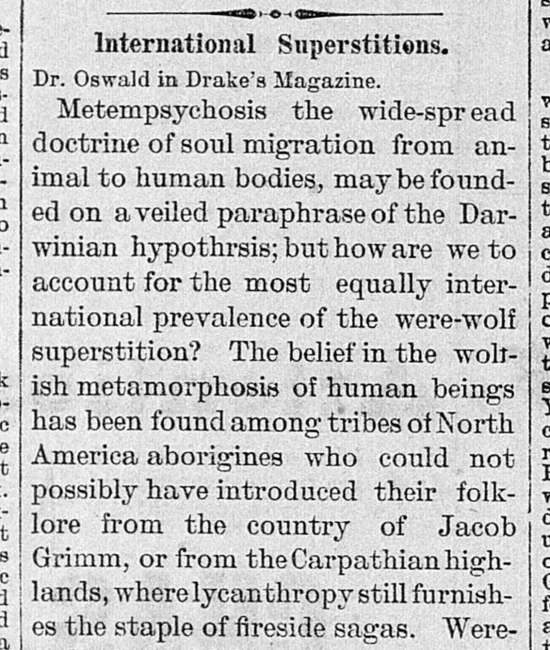
Dr. Oswald in Drake’s Magazine.
Metempsychosis the wide-spread doctrine of soul migration from animal to human bodies, maybe founded on a veiled paraphrase of the Darwinian hypothrsis; but how are we to account for the most equally international prevalence of the were-wolf superstition? The belief in the wolfish metamorphosis of human beings has been found among tribes of North America aborigines who could not possibly have introduced their folklore from the country of Jacob Grimm, or from the Carpathian high lands, where lycanthropy still furnishes the staple of fireside sagas. Were-wolf stories frighten the infant population of the Caffir kraals, of the Tartar tent hamlets, and even of the bush-camps of eastern Australia, where the natives of the Swan River Mountains pretend to trace the footmarks of a suspected wizard in the track of a prowling dingo, or wolf dog. Identity of ancestral traditions seems hardly probable but the coincidence may be explained by the circumstance that among all primitive nations sorcerers were credited with malignant and homicidal motives, and that the natural emblem of that disposition would be the form of the predatory wolf, the chief enemy of pastoral resources. “Homo hominilupus” is the Latin version of various oriental equivalents. The “wolf at the door” is an international metaphor of imminent danger; and in the sagas of the Norse mythology the evil principle itself is typified in the form of the Wolf Fenris, the light-hater, who tracks the steps of Baldur, and at the end of time will consummate the triumph of chaos by swallowing the sun.
The vampire superstition, too, has been proved to prevail among a large number of geographically unconnected nations. It has been found in Abyssinia, as well as among the hill tribes of Reypootana, in northern Hindostan. It was known among the ancient Greeks and medieval Spaniards, and on the lower Danube has often assumed the form of a mental epidemic. The traveler Kohl, and several eminent jurists of eastern Austria, have collected the records of ghoul-resurrections, attested by an incredible number of “credible witnesses,” and repeated with all details of circumstances in Bucharest, Temesvar, Szegedin and the highland hamlets of Servia and Transylvania.
From the New Ulm weekly review., August 29, 1888, New Ulm Minnesota